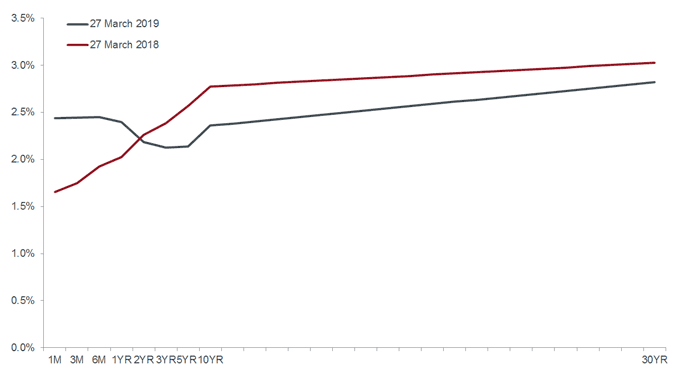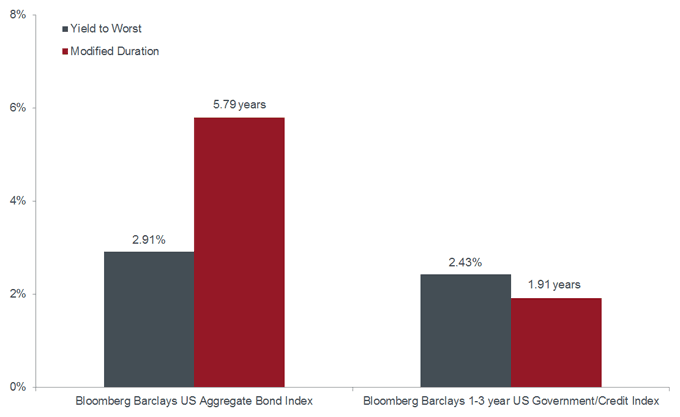Subscribe
Sign up for timely perspectives delivered to your inbox.
Nick Maroutsos, Co-Head of Global Bonds, explains why it is important to focus on quality bonds in periods of potential bond market volatility.
The backdrop for global interest rates has changed significantly since last autumn, but that does not mean risks for bond investors have diminished. While the threat posed by interest rates may have subsided, an extended credit cycle, weakening corporate profitability and myriad geopolitical risks are all factors that could potentially spell upheaval for bond markets. Possibly aggravating the situation are real yields having reset to a higher level, which – as we saw in 2018 – can be an ingredient for increased market volatility.
But with real yields at the end of March 2019 back below 1% in the US and negative across much of the developed world, bond investors still face the challenge of generating sufficient income. Consequently, we again find ourselves in an environment in which a fixed income strategy must work harder to find risk-adjusted return opportunities. This challenge, in our view, is most acute within core bond strategies, especially in regions where benchmark rates hover near 0%. We believe one tactic that merits consideration under such conditions is increasing one’s allocation to short-duration strategies not tethered to traditional bond benchmarks. The combination of greater flexibility in calibrating duration and credit exposure, along with the potential for geographical diversification, may help a portfolio to absorb another round of elevated market volatility. And given the risk factors delineated above, such an eventuality would not surprise us.
With last autumn’s concerns about wage-driven inflation a distant memory and the yield on 10-year US Treasury bonds now back below 2.5%, one may be tempted to increase duration. Reinforcing this view is the US Federal Reserve (Fed) dialling back expectations for a 2019 rate increase and inferring that it would likely cease its balance sheet reduction programme. We are not alone in expecting the Fed’s next move to be a rate cut. The re-emerging dovish bias of global central banks is further illustrated in the European Central Bank’s (ECB) recent decision to introduce a new round of loans to financial institutions.
Despite these temptations, we see little upside in increasing exposure to longer-dated bonds. Our caution is based on the current shape of the US Treasuries yield curve, which is the flattest it has been in the post Global Financial Crisis era, as measured by the spread between the 2-year and 10-year notes. With this term structure, we see little incremental advantage to be gained per unit of risk when extending maturities.
The recent yield curve inversion means that US Treasury bills up to 1-year in maturity yield more than many longer-dated notes, but with lower duration risk.
[caption id=”attachment_144518″ align=”alignnone” width=”680″] Source: Bloomberg, as at 27 March 2019.[/caption]
Source: Bloomberg, as at 27 March 2019.[/caption]
When comparing the Bloomberg Barclays US Aggregate Bond Index with the Bloomberg Barclays 1 to 3 Year Government/Credit Index, the latter’s yield to worst – at 2.43% – offers 84% of the yield of the broader index with only 33% of its interest rate risk as measured by modified duration (see chart 2). In short, investors are not being sufficiently compensated for taking on additional risk.
At this juncture, we see little incremental advantage to be gained per unit of risk when extending maturities.
[caption id=”attachment_144507″ align=”alignnone” width=”680″] Source: Bloomberg, as at 26 March 2019. Note: Duration is a measure of sensitivity of a bond price to changes in interest rates. Yield-to-worst represents the lowest yield that an investor can receive on a bond without the issuer defaulting.[/caption]
Source: Bloomberg, as at 26 March 2019. Note: Duration is a measure of sensitivity of a bond price to changes in interest rates. Yield-to-worst represents the lowest yield that an investor can receive on a bond without the issuer defaulting.[/caption]
Furthermore, with the Fed’s next move likely to be an interest rate cut, we believe that the front end of the curve has greater room to rally than longer-dated securities. Given the low yields on longer-dated government debt, especially in the eurozone, UK and Japan, we see little impetus for prices on these maturities to rise, unless one believes we are on the cusp of a global recession – a potential outcome that has likely decreased due to the recent dovish pivot by the Fed and the ECB.
A low-growth, low-inflation environment at first glance may appear conducive for bonds. Unfortunately, it is occurring during an extended credit cycle in which riskier assets appear richly valued: after last autumn’s spike, the spread on both investment-grade and high-yield corporate credits and their risk-free benchmarks have returned to levels well below their post-crisis average. Should central bank – and market – prognostications of slower economic growth come to fruition, the highly levered balance sheets of the corporate sector may come under pressure as revenue growth slows. A potential warning sign is aggregate revenue growth of the S&P 500 Index component companies only reaching 6%, year over year, in the fourth quarter of 2019.
With interest rates low, however, credit becomes an ever more important factor in generating sufficient yields. Here, too, a greater reliance on an unconstrained strategy may help investors achieve their objectives. While elevated corporate debt levels are prevalent in the US, and Europe is flirting with recession, there are compelling credit stories in other regions that can be accessed when stepping away from regional benchmarks. These stories often encompass robust secular themes such as the growth of banking in emerging Asia and infrastructure spending – often government backed – in several regions. An unconstrained approach allows investors to avoid, rather than just underweight, segments of a benchmark – either a sector or a region – that may be structurally challenged.
Last autumn, we highlighted the need for focusing on regions where monetary authorities were likely to pause, or even cut, interest rates. The US now fits into that camp. Yet, a flat Treasuries curve dissuades one from holding longer-dated duration in the US. So too does the country’s involvement in the ongoing trade spat with China and the political risk emanating from Washington. Other countries, in our view, offer similar interest rate profiles with considerably less baggage.
Last autumn’s volatility – after an extended period of tranquillity – served as a reminder for bond investors that capital preservation is no sure thing. Our greatest concern remains market liquidity. While late 2018 may have caught investors’ attention, the post-crisis market-clearing infrastructure has yet to be truly tested. Given the array of risks in the marketplace, any number of scenarios could lead to a liquidity event in which price dislocations are pronounced. Therefore, investors must remain on high alert for signs of potential market stress. In addition to monitoring liquidity, we believe sufficient respect must be paid to traditional volatility metrics such as interest rate volatility, credit default swap pricing and foreign currency movements. The latter takes on elevated importance as exposure to foreign currency-denominated securities increases.
Vigilance with regard to these metrics may give investors the advanced notice needed to dampen portfolio volatility, but portfolio construction may also further the cause. In an environment marked by low growth and high debt, and with central banks remaining a swing factor in markets, a globally diversified portfolio can help moderate volatility by targeting maturities, regions and issuers with the most attractive risk-adjusted return profiles, while avoiding those where the risk asymmetry is too great.